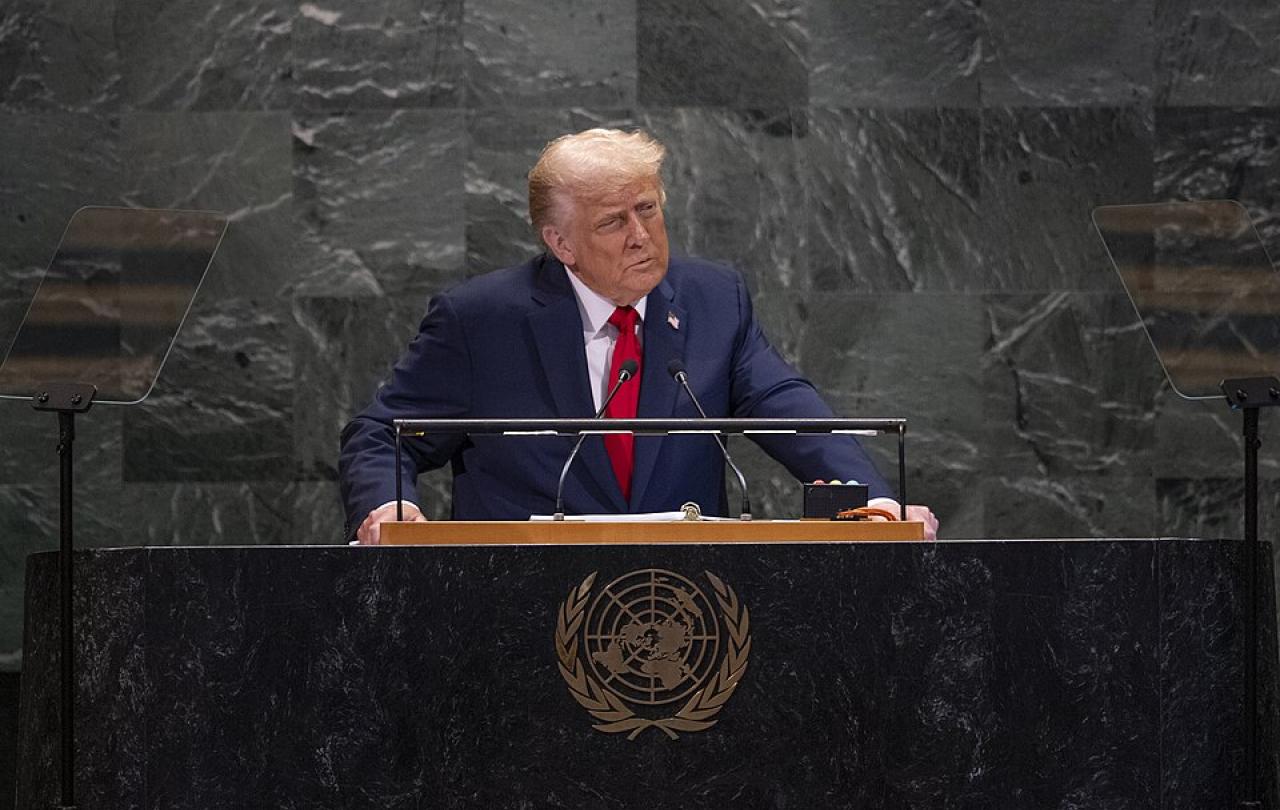
I had never been so self-conscious of being British. I had flown into Denver, Colorado and for the first time I realised that I had an accent. I had gone to study and a Canadian instantly knew I was a Brit. The locals were less clear. Some had me down as an Aussie, others guessed a South African.
But it wasn’t only accents. I quickly learned the differences between us went much deeper. Private health care, guns and the separation of church and state were a whole new cultural landscape. They felt very strange to my British sensibilities that were accustomed to the welfare state, the absence of guns and an established church.
My exposure to all things American began in the early 1990s. The sociologist James Davison Hunter had just published his prophetic commentary, Culture Wars: the struggle to define America. For those I was beginning to get to know, the campaigns to reverse Roe Vs Wade and ban abortion, along with active attempts to introduce prayer into the public school system highlighted the cultural differences between us.
Likewise, they found it hard to comprehend that in England Religious Education (RE) in state-funded schools was mandated by Act of Parliament. That I considered this a bad thing mystified them.
The world we are living in has changed. Issues around religion have become more critical than at any point in my lifetime.
Of course, RE itself had a chequered history. The 1902 Education Act provided state funding for denominational religious instruction, mostly benefiting the Church of England. Nonconformist churches were outraged at the thought of the established church indoctrinating their children. Methodists, Baptists and Congregationalists withheld their taxes and, by 1904, 37,000 summonses had been issued, thousands had their property seized and 80 had gone to prison in protest.
Thankfully things have moved on. During the twentieth century denominational instruction evolved through several stages to the present world religions curriculum.
Still, over the years I have consistently felt that our approach in the UK was in danger of proving ‘the inoculation hypothesis’ with regard to faith. That is, providing a small harmless dose of exposure to religion in childhood can effectively prevent the real thing developing in adults.
Of course, faith-based schools and RE remain hot topics. Only this month the government launched a public consultation on removing ‘… the 50 per cent cap on faith admissions’. Warmly welcomed by providers like the Catholic Schools Service, it was condemned by Humanists UK and others advocating a fully secular provision.
This line of contention has become a familiar one. On one side sit around a third of mainstream state schools that are church or faith-based, most affiliated with the Church of England. On the other are groups like the National Secular Society who correctly point out that the privileged position of church-sponsored education is not reflective of wider society.
These positions have become entrenched over the years. Arguments are laced with rhetorical hyperbole and are often either ill-informed or merely raise strawmen arguments to symbolically knock down. We can no longer afford to be so self-indulgent.
The world we are living in has changed. Issues around religion have become more critical than at any point in my lifetime. It is now more important than ever that we have a handle on it.
And then there’s the frequent stereotyping of religion in the media. Off-the-peg religious reporting ‘templates’ are easy to use but are ‘lazy’ journalism.
The invasion of Ukraine by Putin’s Russia is no mere materialist land-grab. To fail to take into account the theological dimension compromises any understanding of what is going on. The history of Eastern Orthodoxy and the Russian Orthodox Church help define the Russian identity that sits behind this conflict.
In Israel, the bloody atrocity enacted on Israeli citizens by Hamas, and the brutal devastation wrought in Gaza by Netanyahu’s Israeli Defence Force are beyond words. But this conflict is theologically as well as politically fueled. Hamas embraces a militant interpretation of extremist Sunni Islam, while Netanyahu’s religious-nationalist coalition sees his Likud party kept in power by ultra-Orthodox parties and far-right religious factions.
In India, the world’s biggest democracy, 970 million voters this year participate in an election stretching over six weeks. Yet this formally secular state has been travelling on a different trajectory. Yasmeen Serhan observed in The Atlantic that under Prime Minister Modi the ‘Hinduization of India is nearly complete’.
And then there’s the frequent stereotyping of religion in the media. Off-the-peg religious reporting ‘templates’ are easy to use but are ‘lazy’ journalism.
A leading newspaper recently carried instant opposition to the thought of Kate Forbes being a potential First Minister of Scotland because of her ‘traditionalist’ views. Somehow, her commitment in a BBC interview to defend the right to same-sex marriage even though it clashed with her personal views was insufficient.
Across one of my social media feeds as I was writing this piece came a plea, ‘I’m proud to be British. I’m proud to be a Muslim. I am not a terrorist. Why don’t they get it?’
Maybe the American approach to religion goes a long way to explain something of their culture wars.
But always there is America. And here’s where a penny unexpectedly dropped for me. If you keep religion out of schools, for many young people you deny them the tools, the ideas, and a framework with which to understand the religious dimension of life. This can have catastrophic implications.
As G.K. Chesterton is reputed to have observed, ‘when people stop believing in God they don't believe in nothing; they believe in anything.’
Then, for those living within a practising religious home, the absence of religion in school heightens the possibility that their thinking is siloed purely in their own rarefied tradition.
Maybe the American approach to religion goes a long way to explain something of their culture wars.
If it's true that whatever happens in America inevitably makes its home in Britain, we need to sit up and take notice. More than ever, we need our young people to be adept at understanding the religious landscape. With the ubiquity of social media, the unseen influence of echo-chamber algorithms and the nefarious activities of those bent on radicalising the vulnerable, we need them to have the tools and skills to be aware, see and understand.
This is what has caused me to think again and, surprisingly, change my mind. We need to draw a line in the sand on our historic arguments, disagreements and differences of conviction. The situation is more pressing. We need a reset.
If democracy is not a zero-sum game where the majority gets to impose its will tyrannically on the rest, this has to be a way forward.
The encouraging thing is that the groundwork for such a step change is already in place. In 2018 the Commission on Religious Education (CoRE) proposed a reconceiving of the subject as Religion and Worldviews. Their intention was to make it more appropriate and inclusive for the twenty-first century. For them, the ‘complex, diverse and plural’ landscapes of different religions and worldviews deserved both understanding and respect. Yet, students also needed to develop the ‘necessary critical facility to ask questions and challenge assumptions’.
Such an approach embraces the insights and philosophical commitments of non-religious worldviews too. ‘Everyone has a worldview’, said the report. Nobody stands nowhere was the title of an excellent animated short film on YouTube produced by the Theos think tank.
The truth is, ‘everyone comes from somewhere’. This is as true for secular humanists as it is for cradle-to-grave Anglicans, majority-world Pentecostalists and British-born Muslims. Helpfully CoRE defines a worldview as:
… a person’s way of understanding, experiencing and responding to the world.
The report maintained that it was vitally important that different worldviews were understood as ‘lived experience’. This was not just about abstract beliefs, doctrinal understandings and theoretical convictions. This was about real people, the lives they live and what is important and gives meaning to them.
If living in a genuine democracy is about learning how to rub along together. If it is about understanding and respecting those who have a different take on life than we do, no matter how ‘odd’ it seems. If democracy is not a zero-sum game where the majority gets to impose its will tyrannically on the rest, this has to be a way forward.
Given the challenges that face us, it seems to me that not to change our approach to RE would be negligent. Yet to remove all reference to religion from our schools risks our young people falling prey to manipulation, subversion and control by bad actors, misinformed activists and cranks.
These would be the seeds of our very own culture wars.
Personally speaking, I’d rather not go there.





